| The local population greatly increased
throughout the 19th century. In 1831 the population
of Wolverhampton was approximately 35,350, which had
risen to 47,000 in 1841, and 49,985 in 1851, an
increase of 14,635. In 1831 the population of Upper
Penn and Lower Penn was 863, which had risen to 942
in 1841. Because of this increase, a committee was
formed at St. Bartholomew’s Parish Church, to
consider the possibility of building a chapel of
ease to cope with the increased number of
worshippers. The committee, under the jurisdiction
of the vicar, Rev. F. H. Paley decided that a
suitable site would be close to the toll house on
Penn Road, that was near the junction with Coalway
Road and Goldthorn Hill.
Rev. Paley contacted some of the wealthier local
inhabitants in the hope that they would contribute
land and funds for the new church. William Hanbury
Sparrow, of Penn House, Penn Road, who with his
brother John Sly Sparrow, owned Bilston Mill
Ironworks, Stow Heath coal and ironstone mines and
Stow Heath Ironworks, promised to give £1,000 along
with a substantial contribution towards the building
of the church. Also contacted was Rev. William
Dalton and his wife Sarah, who lived at Lloyd House,
on the Lloyd estate off Stourbridge Road. Rev. and
Mrs. Dalton promised to give an endowment of £2,000
in return for the patronage. |
| The part of Penn Fields
where the church was built. From the 1843 Tithe map: |
|
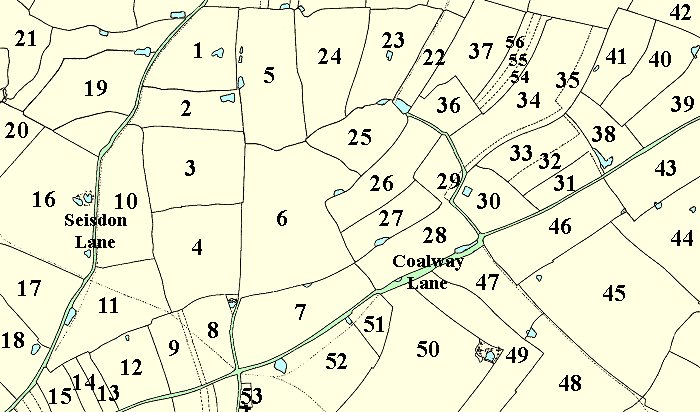 |
| |
|
Field Name |
Owner |
Occupier |
Use |
|
1. |
|
Big Ox Barn Piece |
Thomas Perry |
Thomas Gibbons |
Meadow |
|
2. |
|
Little Ox Barn Piece |
Thomas Perry |
Thomas Gibbons |
Meadow |
|
3. |
|
Lower Bradmore |
Thomas Higgins Burne |
Edward Tandy |
Arable |
|
4. |
|
New Bradmore |
Thomas Higgins Burne |
Edward Tandy |
Arable |
|
5. |
|
Bradmore Meadow |
Thomas Higgins Burne |
Edward Tandy |
Meadow |
|
6. |
|
Bradmore |
Thomas Higgins Burne |
Edward Tandy |
Arable |
|
7. |
|
Coalway Piece |
Thomas Higgins Burne |
Edward Tandy |
Arable |
|
8. |
|
Newcroft Gate Piece |
Duke of Sutherland |
Edward Tandy |
Arable |
|
9. |
|
Newcroft Gate Piece |
Duke of Sutherland |
Edward Tandy |
Arable |
|
10. |
|
Bradmore |
Duke of Sutherland |
Edward Tandy |
Arable |
|
11. |
|
Byngs Pit |
Duke of Sutherland |
Edward Tandy |
Arable |
|
12. |
|
High Tree Piece |
Rev. William Dalton |
Joseph Sheppard |
Arable |
|
13. |
|
Merry Hill |
Vicar of Penn |
William Grove |
Meadow |
|
14. |
|
Little Merry Hill |
Duke of Sutherland |
Edward Tandy |
Arable |
|
15. |
|
Little Merry Hill |
Thomas Higgins Burne |
Edward Tandy |
Arable |
|
16. |
|
Near Big Lord's Moor |
Duke of Sutherland |
Sarah Bate |
Arable |
|
17. |
|
Miller's Piece |
Bradney William
Pershouse |
Elizabeth Thurstans |
Arable |
|
18. |
|
Merry Hill Piece |
Rev. William Dalton |
Joseph Sheppard |
Arable |
|
19. |
|
Lord's Moor |
Duke of Sutherland |
Sarah Bate |
Meadow |
|
20. |
|
Far Big Lord's Moor |
Duke of Sutherland |
Sarah Bate |
Arable |
|
21. |
|
Lower Meadow |
Thomas Perry |
Joseph Cheshire |
Meadow |
|
22. |
|
Lower Slang |
Bradney William
Pershouse |
George Stubbs |
Meadow |
|
23. |
|
Near Gorton's Piece |
Rev. William Dalton |
Joseph Beddard,
Senior. |
Arable |
|
24. |
|
Far Gorton's Piece |
Rev. William Dalton |
Joseph Beddard,
Senior. |
Arable |
|
25. |
|
Horton's Field |
Duke of Sutherland |
Edward Tandy |
Arable |
|
26. |
|
The Meadow |
Bradney William
Pershouse |
George Stubbs |
Meadow |
|
27. |
|
Cloddy Mere |
Heirs of Thomas Bate |
Sarah Bate |
Arable |
|
28. |
|
Cloddy Mere |
Duke of Sutherland |
Edward Tandy |
Arable |
|
29. |
|
Cloddy Mere or
Hembul Head |
William Thacker |
Edward Tandy |
Arable |
|
30. |
|
Little Moors |
Rev. William Dalton |
Joseph Beddard,
Senior. |
Arable |
|
31. |
|
Part of Beckmaster
or Moors |
Rev. William Dalton |
Joseph Beddard,
Senior. |
Meadow |
|
32. |
|
Part of Beckmaster
or Moors |
Duke of Sutherland |
Joseph Beddard,
Senior. |
Meadow |
|
33. |
|
Part of Beckmaster
or Moors |
Rev. William Dalton |
Joseph Beddard,
Senior. |
Meadow |
|
34. |
|
Big Beckmaster |
Heirs of Thomas Bate |
Sarah Bate |
Arable |
|
35. |
|
Big Beckmaster |
Duke of Sutherland |
Sarah Bate |
Arable |
|
36. |
|
Beckmaster Meadow |
Rev. William Dalton |
Joseph Sheppard |
Meadow |
|
37. |
|
Beckmaster |
Heirs of Thomas Bate |
Sarah Bate |
Arable |
|
38. |
|
not recorded |
Devisees of Thomas
Hill |
Charles Butler |
Pasture |
|
39. |
|
not recorded |
Devisees of Thomas
Hill |
Charles Butler |
Pasture |
|
40. |
|
not recorded |
Devisees of Thomas
Hill |
Charles Butler |
Pasture |
|
41. |
|
not recorded |
Devisees of Thomas
Hill |
Charles Butler |
Pasture |
|
42. |
|
Chequer's Field |
Duke of Sutherland |
Anne Hollis |
Arable |
|
43. |
|
Lower Well Piece |
Rev. William Dalton |
Joseph Beddard,
Senior. |
Arable |
|
44. |
|
Simpson's Piece |
Rev. William Dalton |
Joseph Sheppard |
Pasture |
|
45. |
|
Broom Hills |
William Thacker |
John Morris |
Arable |
|
46. |
|
Penn Leasow |
Rev. William Dalton |
Joseph Sheppard |
Arable |
|
47. |
|
Little Broom Hill |
Duke of Sutherland |
Anne Hollis |
Arable |
|
48. |
|
Big Broom Hill |
Duke of Sutherland |
Anne Hollis |
Arable |
|
49. |
|
Roundabout |
Heirs of Thomas Bate |
Sarah Bate |
Arable |
|
50. |
|
Black Ridge |
Heirs of Thomas Bate |
Sarah Bate |
Arable |
|
51. |
|
Little Meadow |
Thomas Higgins Burne |
Edward Tandy |
Meadow |
|
52. |
|
Barn Piece |
Thomas Higgins Burne |
Edward Tandy |
Pasture |
|
53. |
|
Ox Barn
Farm House, Buildings, Yard & Garden |
Thomas Higgins Burne |
Edward Tandy |
Ox Barn Farm |
|
54. |
|
Beckmaster Leasow |
Rev. William Dalton |
Joseph Sheppard |
Arable |
|
55. |
|
Beckmaster Leasow |
Duke of Sutherland |
Joseph Sheppard |
Arable |
|
56. |
|
Beckmaster Leasow |
Rev. William Dalton |
Joseph Sheppard |
Arable |
|
|
|
William Dalton married
the wealthy Sarah Marsh, the daughter of
Samuel Fereday of Ettingshall. She was the
widow of Richard Marsh, who owned a lot of
land in both Penn and Wombourne and
inherited a large sum of money from him. Samuel Fereday was born in 1758 and died in
1839. He married Ann Bagley, daughter of
Dudley Bagley, who was an ironmaster at Lye.
They had three children, Ann, Sarah and
Dudley. Samuel began working as a farmer at
Park Farm, in an area with plenty of coal
and iron ore deposits and started mining
them. His farmhouse became known as
Ettingshall Park.
Samuel was one of the
most important local ironmasters in the
early years of the 19th century. He was a
colliery owner and banker, who with his
partners, John Read, Richard Smith and
George and Thomas Stokes, owned Priestfield
Furnaces at Bilston. The ironworks opened in
1808 and had three blast furnaces. He paid
his workforce with one penny copper tokens
that were manufactured by Edward Thomason,
whose factory produced over two million of
them for him. At one time, Fereday employed
nearly 5,000 people.
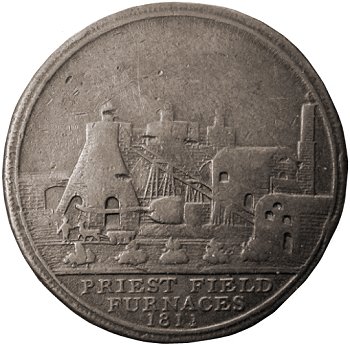 |
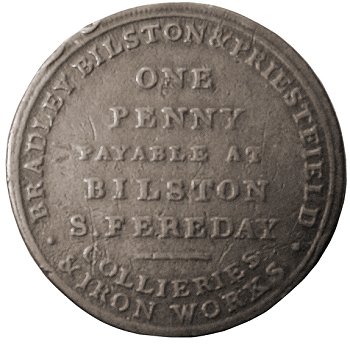 |
|
One of the
penny tokens. |
After the end of the
Napoleonic Wars in 1815 there was a slump in
the iron trade. A great amount of iron had
been produced for armaments, which were no
longer required. Sadly Samuel Fereday went
bankrupt in 1816 after failing to obtain a
French import licence for 200 miles of pipe
for Paris. After failing to get his
bankruptcy papers in 1821, he went to
France, where he ran a factory producing
plate iron in 1823, which at the time was in
great demand.
He died on the 30th
March, 1839, aged 81, at Capelle, near
Boulogne.
William
Dalton
William Dalton was an
Irish minister who was born in born in
Kilcoo, County Down. In 1827 he helped to
form the Protestant Reformation Society and
preached at several places in England. His
visit to Liverpool was so successful that
some of the inhabitants offered to build a
church for him to be called St Jude’s. He
intended to take-up their offer until he
preached in St. George’s Church in
Wolverhampton and met Sarah Marsh, who was
fascinated by him. She invited him and his
friends to dinner and gave a large donation
to their cause.
They decided to marry,
and he stayed at Sarah’s home, Lloyd House,
for a few months each year until a permanent
position could be found for him in the
Wolverhampton area. He had signed a contract
with the people in Liverpool and so he also
lived there and bought a home in Toxteth
Park. They married in June 1831 at St
James', Piccadilly, and in 1832 Sarah
returned to Lloyd House.
At this time, a friend
of the Daltons, Dr. McNeil, Rector of Albury
was having great problems with his patron
and William Dalton suggested that he should
take over his church at Liverpool, which
solved the difficulty with his contract.
Sarah also managed to get William appointed
as vicar of the new St. Paul’s Church, off
Penn Road. A position he held from 1835
until 1859, when he became Perpetual Curate
of St Philip’s on 21st October 1859.
He formed a local
Clerical Society, which regularly met at
Lloyd House, but sadly Sarah Dalton died on
the 19th February, 1862 after a long and
painful illness. In her will, the Lloyd
estate and its land at Penn and Wombourne
were left to William Dalton. A memorial
window was placed in St. Bartholomew’s
Church to the memory of Sarah, at the
expense of the tenants of the Lloyd Estate.
On the 16th June, 1864, William Dalton
married Mary Isabelle Chalfont, of Asprey
Lodge, Bedfordshire, who was half his age.
They lived at Lloyd House until his death on
the 13th May, 1880. He was buried in the
family vault in Wombourne parish church.
After his death, Mary moved to Eastbourne,
where her new home was called ‘The Lloyd’.
The building
of St. Philip's Church
The church was built
off Coalway Road in 1858 and 1859 beside a
small lane leading to an area of farmland.
At that time, the site called 'Cloddy Mere',
with about an acre of land, was given by
William Hanbury Sparrow of Penn Court. To
ensure their patronage, the Dalton's
contributed £3,000 towards the building of
the church.
|
|
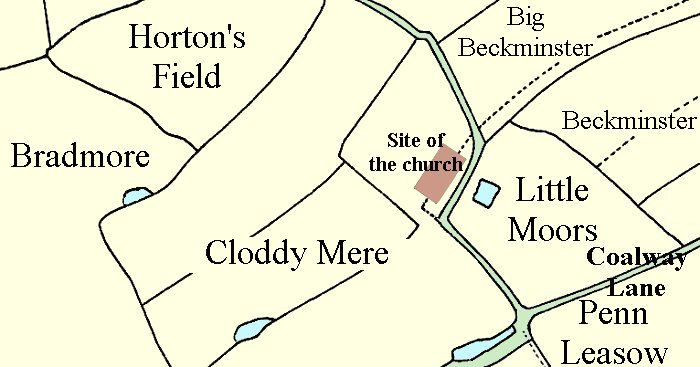
The area where the church
was built. |
| The corner stone was laid on the 13th May,
1858 by William Hanbury Sparrow and completed in 14 months. It was
consecrated on the 8th July, 1859 by the bishop
of Lichfield. The church was designed by
Griffin & Weller of Wolverhampton and built by
John Cockerill of Wolverhampton.
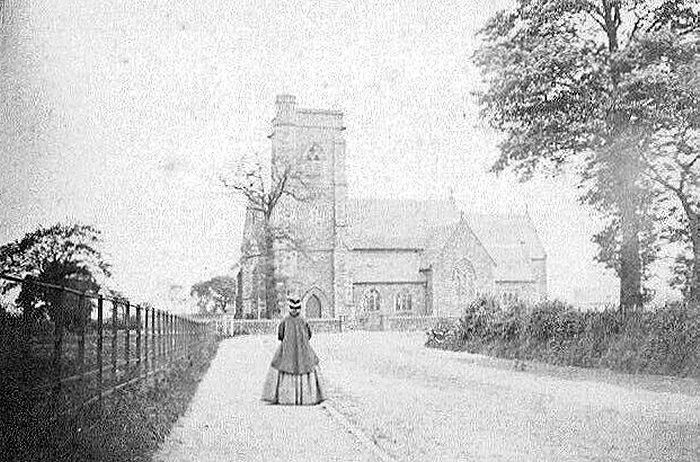
An early view of the
church.
The gothic structure is built of red sandstone with Bath
stone window dressings and consists of a nave
with north and south aisles, north and south
transepts, a chancel with a south chancel aisle,
an organ chamber and a vestry. In the chancel
there are polished Devonshire marble pillars
that were supplied by Philip Horsman of
Wolverhampton. The tower is about 80 feet high
and contains a spiral stone staircase. The
entrance porch has an inner partition that was
added in about 1900. The church has two bells,
one cast by Warner & Company of London in 1859
and a second bell that was added in 1902. It was
a gift from Mrs. Hannah Page of Penn Road. The
church clock also dates from 1902.
As built, there was seating for 506 adults
and 119 children, 319 of which were rented to
worshippers to provide part of the income for
the vicar. The other seats were free for anyone
to use. In 1951 all of the seats became free to
use. Some of the seats were later removed, which
reduced the seating accommodation to around 530.
The brass lectern was a gift from the Lloyd
Clerical Society and the pulpit is made of Caen
stone, as is the font, which was carved by Mr.
Wood of Lichfield.

The church interior.
A red sandstone wall was built around the
graveyard and a coach house with a two-stall
stable with a loft was built in 1859 to stable
Mr. and Mrs. Dalton's horses that pulled their
carriage to and from Lloyd House, where they
lived. The vicarage next to the church was built
in 1881 for the second vicar, Rev. W. G. Vernon,
who had lived at Westdale Villa, Compton Road,
on the corner of Westland Road. The site was
originally part of 'Cloddy Mere' which was given
to the church by William Hanbury Sparrow. The
Church Commissioners gave £950 for the building
work. The vicarage ground floor contained 3
sitting rooms, a toilet, front and back
kitchens, a pantry and a larder. There were 4
bedrooms on the first floor and 3 attics and a
box room on the second floor. There was also a
small wine cellar, a boot room, a coal house and
ash pit, and 2 outside toilets.
The burial ground, known as Glebe Field, was
purchased by the Rev. W. G. Vernon from William
Hanbury Sparrow's son, Arthur, on the 20th
January, 1887 (William Hanbury died in 1867).
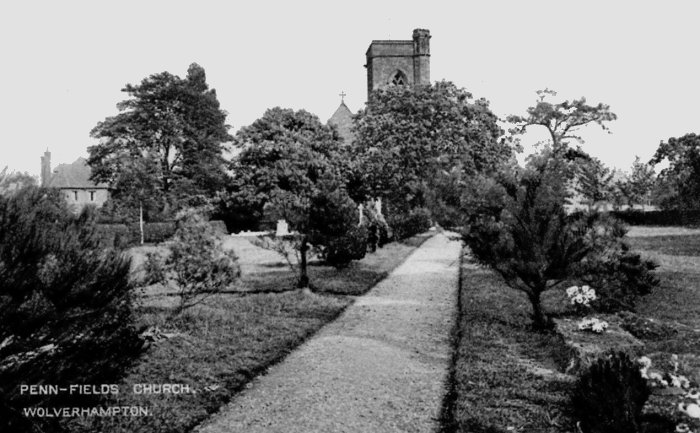
The burial ground. From an
old postcard.

Another early view of the
church. From an old postcard.

The church and the fields
that once surrounded it. From an old postcard.
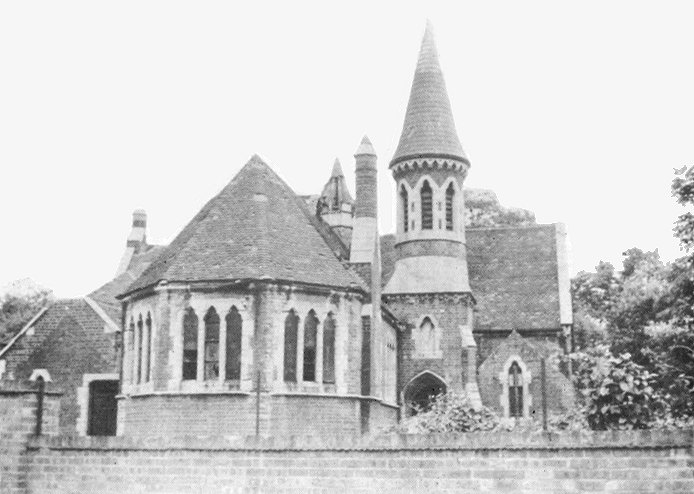
St. Philip's Day School.
St. Philip's Day School was built in 1863 in Church Road, where
Ackleton Gardens is today. It was designed by W. D. Griffin and
built by Lovatt of Wolverhampton at a cost of around £1,000. The
headmistress was Miss Jane Blake and the headmaster was Mr. George
Benson. When the school opened in 1863 there were 64 pupils, but by
1910 there were over 300 pupils. The school continued in use until
1928 when the local authority took it over and the pupils were
transferred to Bradmore Council School. The building in Church Road
was sold in 1928 to Boswell and Tomkins for £600 and was used by the
Salvation Army. In 1945 it was acquired by the Wolverhampton Die
Casting Company and then demolished in the early 1960s to make way
for Ackleton Gardens.
The Church Hall in Church Road was built in
1898 and 1899 by A. W. Hickson & Company, to a
design by Mr. Lavender, who was leader of the
Church's Sunday school. The foundation stone was
laid by the Mayor of Wolverhampton, Alderman
Alexander McBean, on the 5th October, 1898. The
hall was a large room that could accommodate 200
people with a folding screen across the centre
to convert it into two separate rooms. There was
also a kitchen.
Around 1926 the County Council
began to use the hall as an infant welfare
centre on Wednesday afternoons. The front half
of the hall was fitted with a moveable partition
to provide a waiting room and a doctor's room.
From 1949 until about 1958 the building was used
by Wolverhampton Corporation as extra space for Woodfield Avenue School. In 1976 and 1977 a new
entrance hall was built between the two halls
along with ladies', and gentlemen's toilets and
improved kitchen facilities.
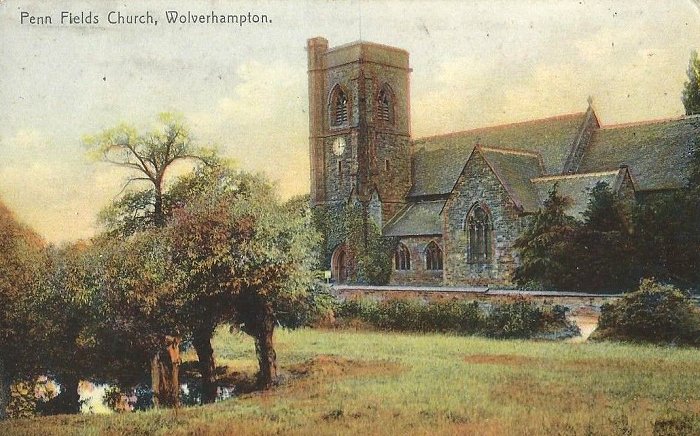
The church before the
building of the war memorial and gardens. From
an old postcard.
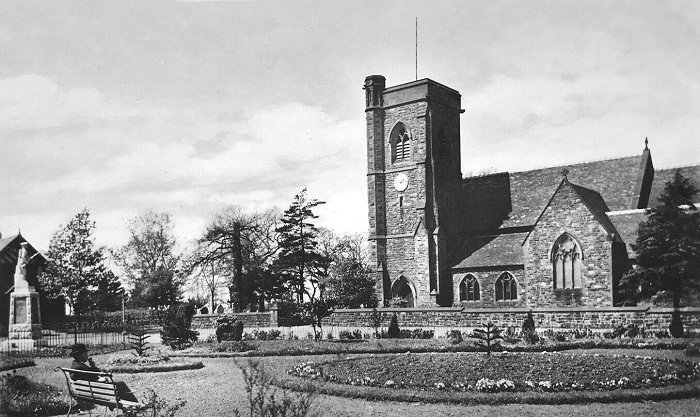
The church and war
memorial. From an old postcard.

Church Road and the
church. From an old postcard.
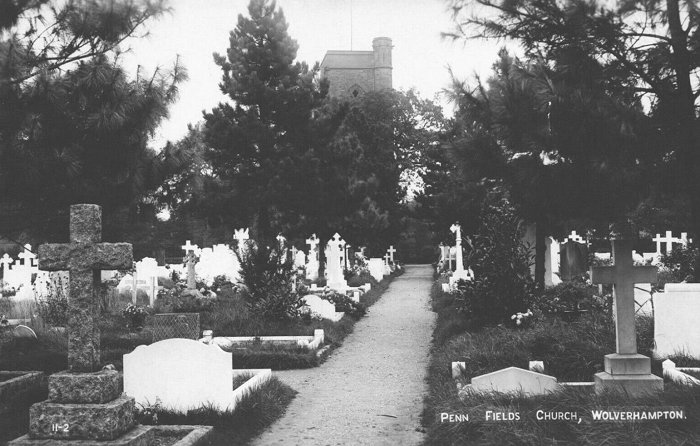
The burial ground. From an
old postcard.
In 1959 when the church celebrated its
centenary, around £2,200 was spent on
redecoration and the replacing of some of the
old floor tiles and the iron grills in the
aisles. The chancel roof was painted and oak
facing was added to the choir stalls, organ
chamber, entrance porch and doors. The
contractors were William Gough & Sons Limited.
In 1996 and 1997 the main body of the church
was divided horizontally, with worship taking
place on the upper floor and with function rooms
and the church office on the lower floor. |
|
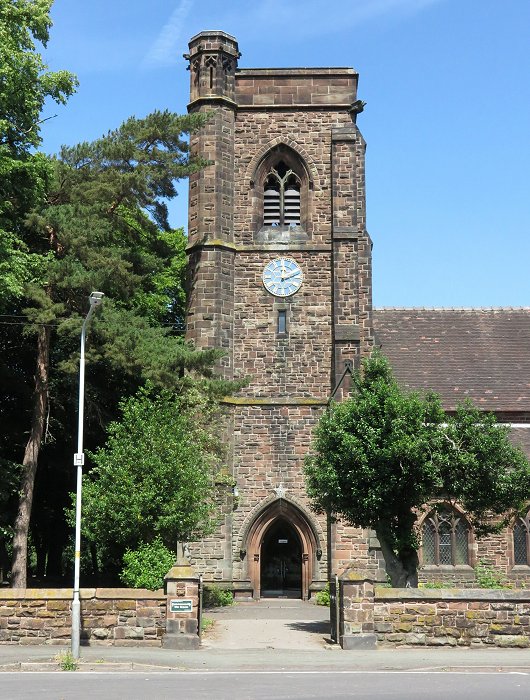
The church in 2021. |
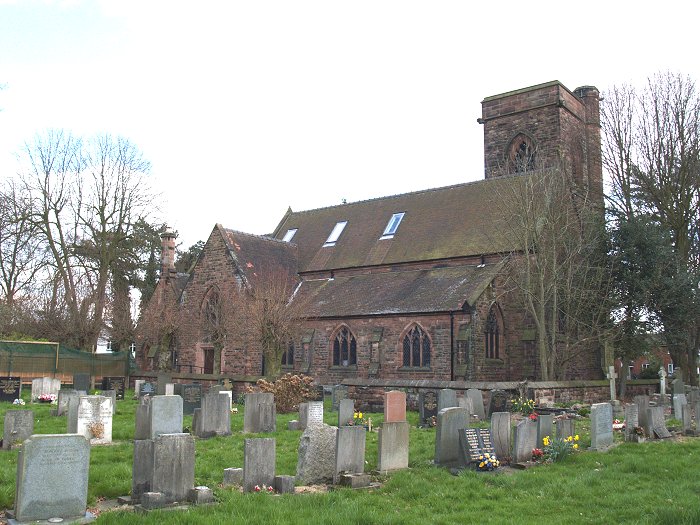
The church and burial ground in
2020.
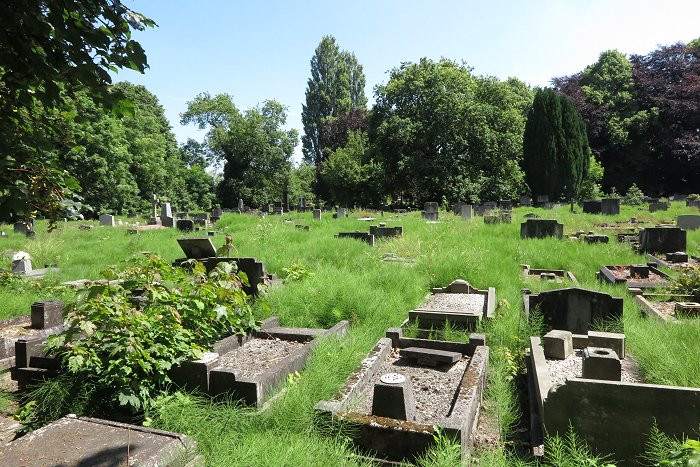
The burial ground in 2021.
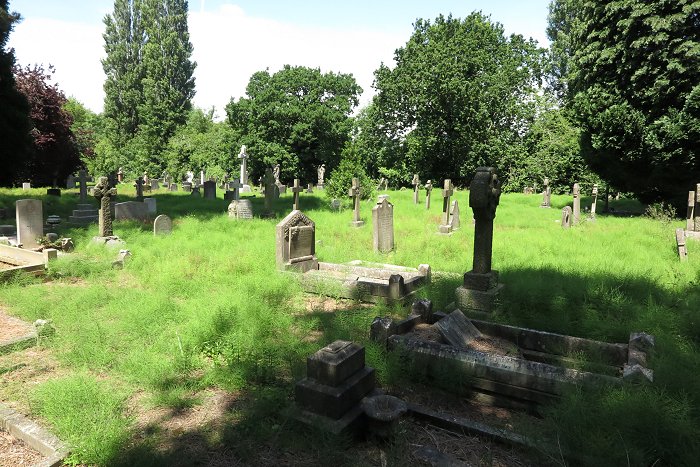
The burial ground in 2021.
 |
Return to the
previous page |
|